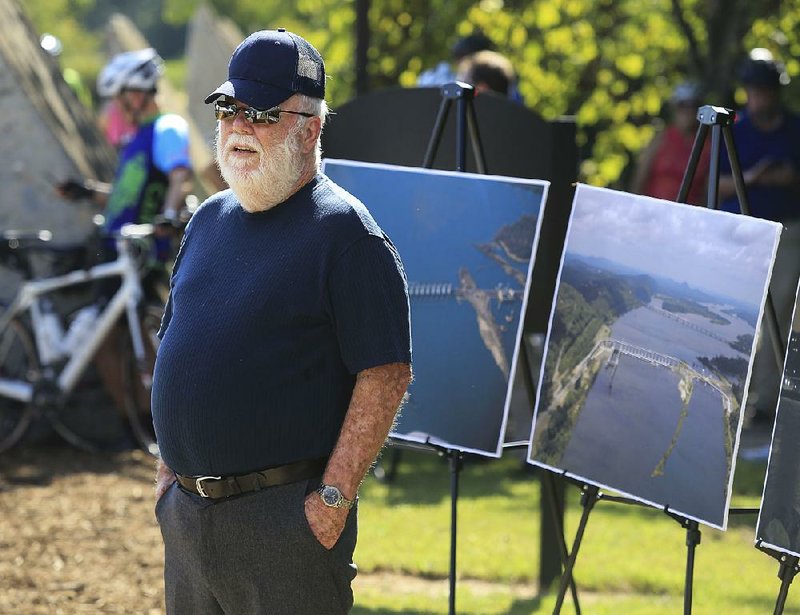Buddy Villines stood out Thursday morning among the officials sweating in suits and dresses at the base of the Big Dam Bridge, looking very retired in a T-shirt and ballcap.
The former county judge for Pulaski County who helped push the public works project through, says the bridge has "done everything I thought it would do" to improve health and economic development. People stop him two to three times a week to thank him. They tell him it changed their lives by getting them walking. Others have told him they moved to Little Rock because of the trail system that sprung up around the bridge, he said.
He thinks the potential for the bridge's contribution to the Little Rock-North Little Rock community is just getting started, though.
"Because it's so big," Villines said. "It's really bigger than life, and communities need that. They think, what else can we do?
[BEFORE AND AFTER: Compare the Big Dam Bridge when it was under construction versus now]
"In the past, people said, 'We're just central Arkansas.' Now, with the bridge, the [Verizon] arena, it gives confidence as a community, knowing we could do big things."
A gathering of local, state and federal public officials joined bicycle advocates Thursday to celebrate the 10th anniversary of the $12.8 million bridge.
It is definitely a big bridge.
At 4,226 feet, or about 0.8 mile, officials say it is the longest bridge in North America built expressly for pedestrians and bicyclists. The Chain of Rocks Bridge in St. Louis is longer at 5,350 feet, but it was built in 1929 as part of U.S. 66, reopening in 1999 for pedestrians and bicyclists exclusively.
The Big Dam Bridge, built atop the Murray Lock and Dam, connects Cooks Landing Park in North Little Rock with Murray Park in Little Rock. It serves as the western link to the 15.6-mile Arkansas River Trail loop.
The name for the bridge originated when Villines' exclaimed during a tense meeting on the subject, "We're going to build that big dam bridge." In Villines' telling, a pause ensued while the others thought he had sworn, until they figured out he was referring to the Murray Lock and Dam.
His successor as county judge, Barry Hyde, credited the bridge on Thursday as the cornerstone of a developing trail system that has given central Arkansas a national identity. Quality of life is becoming more of a factor in where people choose to live and work, Hyde said, and the bicycle trails make a big difference.
The eventual goal is to extend the trail from Little Rock to downtown Hot Springs. The project is requiring collaboration from the city and county governments in Pulaski, Saline and Garland counties, he said. But the example set by Villines and former mayors Patrick Hays of North Little Rock and Jim Dailey of Little Rock is helping.
"It's very encouraging," Hyde said. "There's a lot of enthusiasm for this. Back when the bridge was being started, there were a lot of naysayers. Every way you try to measure the bridge, it's been a success."
The bridge cost $12.8 million. Work crews later added a western-facing ramp on the Little Rock side at a cost of $4 million. In 2014 LED lights were replaced, and additional security cameras added, at a cost of $628,750. The lights were supposed to last 10 years but lasted eight. Bathrooms are under construction for another $230,048. There has been talk of adding 40 additional parking spaces on the Little Rock side at $250,000.
Gretchen Hall, president and chief executive officer of the Little Rock Convention and Visitors Bureau, said it is difficult to trace tourism dollars directly to the bridge itself, but there are several factors it affects. The annual Big Dam Bridge 100 cycling tour makes about $1 million in economic impact in Pulaski County, she said. Officials expect participation to exceed 3,000 riders on Sept. 24, she said. Most riders coming from out of town bring another person, which the bureau factors into projections on gas, food and discretionary spending.
The convention and visitors bureau uses an economic impact calculator from Destination Marketing Association International, a national industry group, she said.
She also said the bureau touts the bridge as an amenity to visitors staying for other events such as the American Taekwondo Association competition.
Bob Major, head of the North Little Rock Convention and Visitors Bureau, said the festival at the end of the Big Dam Bridge 100 brings about $160,000 worth of business to North Little Rock hotels and restaurants. Several breweries that have popped up in North Little Rock, such as Core Brewing Co. and Flyway Brewing Co., are popular for bicyclists who stop while on the trail, he said.
Metro on 09/09/2016

